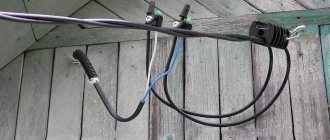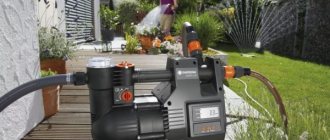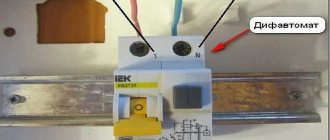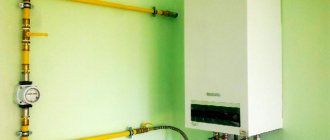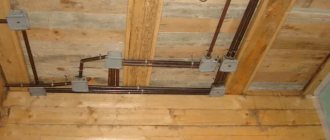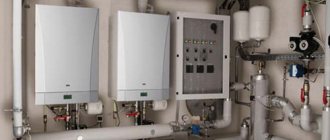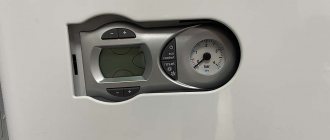Gas heating boiler is connected to the main highway using a flexible sleeve.
Choosing and installing a hose for a boiler is a very important matter , because we are talking about gas.
An incorrect connection to the gas pipeline may result in an explosion .
To supply household gas, flexible gas hoses specially designed for this purpose are used. The use of water hoses for this purpose is strictly prohibited.
Varieties
three types used in everyday life :
- Rubber-fabric.
- Rubber reinforced.
- Bellows.
They are made from various materials, have different technical properties and service life. Each of the three types of gas hoses has both pros and cons. The choice depends on the installation location and the specific case.
Rubber
Rubber hoses reinforced with textile thread are the softest among all types of hoses. They are economical, easy to install and maintain. A wide selection of hoses of this type is available in construction stores. You can easily choose a sleeve of the desired length and diameter .
Photo 1. Rubber soft gas hose, black, is economical and easy to connect.
Rubber gas hose is mainly used in dachas. This method of gas supply is the most affordable and easy to install, but also the most unsafe. Over time, the rubber cracks, which inevitably leads to gas leakage, so the use of this type of connection is only permissible for private sector gas cylinders.
In addition, these hoses lack rigidity and are sensitive to temperature changes. This type of hose is recommended to be replaced every two years, however, in practice they are used much longer. Modern sleeves with elastic components can last up to 5 years .
Reinforced
Much more common are reinforced rubber hoses, which are similar to water supply hoses. They are braided with steel threads on the outside. The inside is made of polymer material, although they are called rubber.
Reinforced hoses are also affordable and easy to use, but they are prohibited in several European countries . Our gas specialists also do not recommend using them or doing so in compliance with a number of rules.
Photo 2. Two reinforced hoses made of polymer material, one covered with corrugated steel on top.
The polymer sleeve inside is destroyed in the same way as the rubber one. In addition, steel is an excellent conductor of current, so it is necessary to use dielectric spacers during installation. When using metal-braided tubes, be sure to turn off the gas taps; this will extend the service life of the hoses. This type of hose can be used at temperatures up to +50 degrees.
Bellows type stainless steel
This is the only type of gas hose approved for household use. It is a dense corrugated braid that is resistant to high and low temperatures, high pressure and mechanical stress. There is a single-layer and multi-layer bellows.
It is made from both metallic and non-metallic materials. The shell creates increased safety; it prevents damage from most types of impacts.
Photo 3. The bellows gas sleeve is yellow, made of non-metallic material, coated with polymer.
This type of hose is made of stainless steel. Gas hoses are sold with and without insulation. The second type is coated with a polymer that does not conduct electricity. A hose with a diameter of at least 10 cm for uniform gas supply. Bellows hoses are an order of magnitude better in quality than others.
Reference! The most reliable samples are those with a polymer coating that protects them from environmental influences. These gas hoses last up to 30 years , they are safer, but also more expensive.
Advantages of bellows hoses for gas:
Connectivity
To connect the heating boiler to the main line, the following conditions must be met:
- The gas appliance must have a fitting with an external thread, which the rubber sleeve can reach.
- For ease of installation, an adapter in the form of a brass corner is installed.
- Gaskets must be present to prevent gas leakage.
- The end of the hose attached to the boiler is equipped with a mesh that prevents microparticles from penetrating into the device.
At the end of the installation procedure, you can cover the butt joints with a soap solution. The appearance of air bubbles will indicate a gas leak. The connection method is simple, but requires correct adherence to technology.
How to choose the right flexible gas tube?
It is safest to purchase a gas hose in a specialized store that has a state certificate of conformity . It is best to opt for the bellows type of sleeve.
Important! Beware of fakes of poor quality. There is a high probability of purchasing counterfeit goods on the market. This threatens that the sleeve will be made of thin, cheap rubber, which will quickly fail. Most fakes can only be distinguished from the original by a professional.
To identify a counterfeit, you need to carefully study the technical characteristics of the product, passport and certificate of conformity. You should not buy a product at a suspiciously low price.
Before purchasing, you need to take a measurement, then add 20% . You should not purchase a gas hose with a reserve. Standard sizes are 1–2 m. In everyday life, diameters of 1/2 or 3/4 inches are usually used.
The hose comes with two types of fastenings: with two union nuts with internal threads (female-female) or with a nut on one end and a fitting on the other (female-male). The thread is selected depending on the outlet on the device. It is preferable to opt for welded structures rather than those where the fitting is connected to the corrugation with glue.
Installation
The safest thing to do is contact a professional who will ensure the correct connection and provide a guarantee. After all, everyone knows from childhood that it is dangerous to joke with gas.
Characteristics of pipes made of various materials
To help consumers decide which pipe is best to use for underfloor heating, let’s consider the main indicators of the most popular materials.
The most commonly used pipes are copper, polypropylene, metal-plastic and cross-linked polyethylene.
Copper products
Copper is still actively used for the production of heating pipes because it is highly durable. This material is characterized by antibacterial properties and oxidation resistance. In addition, copper products can be operated at temperatures ranging from -100 to +250 ℃ and are quite resistant to mechanical stress.
Provided that copper underfloor heating pipes are installed correctly, the system can operate for approximately 50 years without the risk of melting, warping, or cracking. Despite the high cost of copper pipe products, in the long run such costs will more than pay off.
However, copper pipes also have some disadvantages. In particular, they are quite picky about water hardness and acidity. In particular, when circulating a medium with an alkaline or acidic environment, the system will fail at least twice as fast.
Why is it better to seek help from specialists?
Only the gas supply organization has the right to install gas equipment. It will be better if the technician inspects the entire heating system and identifies shortcomings immediately, rather than this leading to problems in the future.
Gas heating is a dangerous equipment, so consultation with a qualified specialist is a must. Negligence in matters related to gas can lead to tragedy!
The main element in a flexible hose is a rubber hose. When made with high-quality connections, this hose is made from completely non-toxic rubber of a special brand EPDM, this is the so-called ethylene propylene rubber. This material, in case of contact with water, does not emit harmful substances, and it can be used for drinking water supply. It is also quite resistant to high temperatures; this property allows the use of liner when installing heating devices (up to +95 ° C).
The outer braid is the second most important element of the eyeliner. The flexible liner provides the product with sufficiently high strength in the event of external mechanical impacts and internal hydraulic shocks. That is why, externally, the hose is braided with stainless steel thread, thanks to which the flexible water supply will reliably serve for 10-12 years. A high-quality braid will allow the liner to withstand pressure up to 10 atmospheres. If, on the outside, the braid protection is made of aluminum thread, then both the service life and the strength of the product will naturally be less.
The braid is also made from galvanized steel wire; it does not withstand the action of condensation, and provided that it constantly forms, this liner will last no more than a year. Another element is the brass fitting. A fully braided rubber hose is attached to this fitting using a sleeve made of stainless steel. To install the liner, mounting elements are used, these are union nuts or a fitting.
Flexible eyeliner on the verge of failure.
This begs the question: - Why not put it? Bet! Just don’t be lazy to monitor the water supply system, periodically pay attention to the condition, visually and by feeling. 1. If protruding “hairs” of wire appear on the flexible eyeliner, then this is a harbinger of an accident, because if it sticks out, then the same thing happens inside the braid. 2. If brown spots become noticeable, it means that microcracks have appeared in the rubber hose, which means that a break will occur. Pay attention to the water supply of your home and avoid a lot of troubles. 3. When leaving your home for a long period of time, turn off the water supply, use the taps at the inlet for this. If you trust any of your neighbors, leave the keys to your apartment in case of an accident.
Application of flexible water line
The main application of a flexible water line is to connect corrugated stainless steel pipe to household equipment and appliances that use water. For this purpose, there are two types of flexible hoses: fully rubberized hoses with metal braiding and bellows metal hoses; the use of these materials makes connecting the equipment as simple and quite convenient as possible.
Metal-braided rubber hoses are the most common type of hose. Along with the “regular” hose, the “rubber hose in a metal braid” category also includes an anti-vibration hose. A flexible corrugated pipe or liner is, in fact, a universal material; if an accident occurs during the use of heating or plumbing systems, then, in principle, nothing terrible will happen, but if something bad happens during the operation of a flexible gas line, the consequences will be much more dire . But such accidents occur at a minimum, therefore, the flexible supply for heating or gas is made of sufficient quality to be used in absolutely any areas of increased danger.
Such a technically complex element as a universal flexible hose requires the use of only high-quality materials and modern qualified equipment. A guarantee of quality when purchasing flexible braiding is the so-called accompanying passport.
Obtaining hot water for heating and other technical needs is very important. In many cases, special hoses are used in the last section of pipelines. Ignoring strict technical requirements can lead to serious problems.
Pipes and fittings to create a sealed piping system
Currently, when creating durable and reliable communication systems, it is necessary to use high-quality and modern materials and structural parts used for installing a pipeline network. The main elements when carrying out various pipelines include pipes and fittings , as well as couplings, water hoses, flanges and other connecting parts. At the same time, when choosing these products, it is necessary to take into account the wear resistance of parts, their specific gravity, resistance to corrosion and aggressive chemical substances, and throughput.
The most common and widely used materials when creating parts for pipelines are plastic and metal-plastic, which are characterized by lower cost, high technological indicators and characteristics, as well as a long service life.
The catalog of pipes and fittings in our online store is represented by an assortment of products of various modifications and models from, which is a leading company in the production of high-quality products for creating plumbing or heating systems.
Pipes and fittings: types and application features
All pipes used in public utilities are classified into:
· Heating pipes.
· Water pipes.
Heating pipes in the entire system make up only 20% of the cost of all necessary equipment, and not only reliability, but also the quality of heating the room depends on the correct choice.
Modern high-quality water pipes must not only comply with all technological process standards, but also be free from impurities and compounds harmful to the human body. Also, when choosing these design parts, it is necessary to take into account the indicator of resistance to corrosion processes, since during operation a problem with the quality of drinking water may arise.
In addition, a very important issue is the acquisition of connecting fittings and other parts, such as fittings and water hoses , which allow you to create a more optimal pipeline system without the use of more complex and specific equipment.
In order to create an absolutely ideal and efficiently profitable heating system designed to maintain the optimal temperature in the room, just visit our online store, where the catalog of pipes and fittings is presented with all the necessary parts and devices of high quality, confirmed by quality certificates and positive reviews from our customers .
Peculiarities
Hoses for steam and hot water pumping are widely used. They can be found:
in food production;
at an oil refining and petrochemical enterprise;
at a chemical plant.
It is imperative that the hoses successfully withstand high temperatures. The critical value is usually 210 degrees. Hoses resistant to it are used in most industries, including for steam cleaning of surfaces. Hoses for hot water and steam must successfully carry:
Sewerage and water supply
Modern high temperature hoses vary greatly depending on the nuances of use. Thus, for hot water pumped over open areas in the cold season, frost-resistant communications are mainly used. In domestic conditions, if it is necessary to supply liquid at temperatures down to -40 degrees, polyurethane hoses are used. This material is resistant to oil and gasoline, allowing you to pump even sea water and thick mud.
According to experts, it is best to use corrugated hoses for sewer systems. Their increased flexibility is important. Moreover, special ribs also increase the strength of communications. These properties allow you to confidently lay the sewer line to a considerable depth. Adaptation to sudden changes in terrain will not be an obstacle.
Metal-plastic pipes for water floors
Metal-plastic pipes are much cheaper than copper pipes, so they are deservedly popular.
Among the advantages of such products are:
- high resistance to oxidation;
- long service life - about 50 years, as well as copper ones;
- light weight - thanks to this, the pipes are convenient to transport and lay;
- environmental friendliness - polymer materials do not react with impurities in the coolant;
- sound insulation - water passing through pipes does not create as much noise as when in contact with steel.
The structure of metal-plastic pipes involves the presence of several layers - polymer material inside and outside, as well as aluminum, which gives the material strength. The inside surface of the pipe is very smooth, so no plaque forms on the walls. In addition, this layer protects the aluminum and adhesives from water.
Their durability will depend on how high-quality glue is used for the production of pipes. If the adhesive begins to deteriorate, the polymer layers will peel off and the pipe will lose its seal. The quality of the glue can be determined by heating the pipes to 90-100 ℃ and evaluating the result.
Ideally, the appearance of the product when cut should remain the same. If the layers of materials become clearly visible, then you should not opt for these products.
Although metal-plastic pipes cannot withstand open flames, this does not affect the installation of a heated floor. In this case, it is worth thinking about what diameter to choose a pipe for a heated floor, taking into account the available fittings. If their internal cross-section is smaller than the diameter of the pipe, limescale will begin to form on the seams (read: “What is the best pipe diameter for a heated floor to use - calculating the diameter, depending on the pipe material”). Over time, this will lead to coolant leakage.
The operating temperature range for metal-plastic pipes is -10 to 95℃. Short-term heating up to 110℃ is possible. If the pipe overheats, it will be hopelessly damaged.
Please note that when installing fittings, it is important not to overtighten the union nut so that a cut does not form on the surface of the pipe, which can cause a leak. If you do not have the skills for such work, it is better to entrust the installation of heated floors to specialists.
Warm floor
Heat-resistant hoses for heated floors differ from water hoses in that they can also be designed for other liquids. In some cases, antifreeze is poured into these systems. When choosing flexible communications for a heated floor, you need to take into account how much insulation is required. This depends on the climate of the area and how high the temperature will have to be maintained. Metal-plastic elements are mainly used because they last a long time, make almost no noise, and are resistant to strong heat and mechanical stress.
Heating
Heat-resistant flexible pipes for heating are in most cases made of stainless steel. Their advantage is that during operation the chemical composition of the circulating water does not change. The corrugated type of hoses is very resistant to harmful mechanical influences, including hydraulic shocks. But it is critically important to select only impeccably high-quality products. The slightest defects, even the most insignificant manufacturing defect, will have a sharply negative impact on the quality of the heating system.
Stainless steel heating hoses are connected using fittings. Then seals must be used. In addition, you can join parts using:
It should be taken into account that the flexible heating supply may also include rubber hoses. They use only EPDM rubber, which does not have even a slight toxic effect. The design can withstand heating up to 95 degrees. A mandatory component of the liner is a reinforcing braid. If it is made of high quality, from stainless steel, then its service life can be guaranteed for up to 10 years; aluminum or galvanized steel are much worse.
Recommendations for selection
When selecting food hoses for hot water and steam, primary attention must be paid to their strength, throughput, and thermal parameters. But chemical properties are no less important. They also check the method of fastening and the length of the structure. A high-temperature steam hose is most often reinforced with wire. Only with minimal steam pressure is it permissible to use lines reinforced with fabric.
According to experts, the highest operating pressure should be 10 times lower than the burst pressure. Most steam generator hoses are made with a cross-section of 2.5 or 3.2 cm. You should definitely check what substances they are made of. If the mixture settles near the fittings, steam leakage is inevitable. Hoses rated for 100 degrees are impractical; it is best if they can withstand temperatures up to 220 degrees.
Insulated hoses are more correctly called pipes. A heating cable can be used as a heating means. Occasionally, shell coating made of polyurethane foam or polystyrene foam is used. Typically, a protective layer is used for underground routes. Surface pipelines are made mainly with cables.
For heated towel rails, flexible hoses are not used at all. It is better to adjust the location of the pins. Coils for moonshine stills are mainly made of silicone. We must carefully check that PVC is not sold under the guise of silicone. Many sellers themselves do not understand the difference.
For heat removal of air, only hoses that meet sanitary standards are selected. The frequency of air exchange and the intensity of ventilation are taken into account. Calculate the optimal thermal regime. It is necessary to compensate 100% of heat loss.
XLPE heating hoses
Polyethylene itself consists of hydrocarbon molecules that are not connected to each other. Cross-linked polyethylene (PEX) is made using new technologies that push carbon and hydrogen atoms together. Subsequent processing under high pressure leads to the formation of additional molecular bonds, as well as an increase in the strength of the material.
Despite the fact that this technology was invented more than 40 years ago, mass production of red pipes for heated floors from a new material began not so long ago. It is characterized by high strength, resistance to abrasion and mechanical damage, does not crack and is not afraid of temperature changes. How pronounced certain characteristics of the material will be depends on the method and degree of crosslinking.
The best option for a heated floor would be a material with a degree of cross-linking in the range of 65-80%. Accordingly, the higher the degree, the better the product and the higher its cost. However, due to the durability of the pipes, the extra costs for them will soon pay off.
With a low degree of cross-linking, the pipes will not be able to withstand increased loads. In addition, it matters what method the molecules were connected by - nitrogen, peroxide, radiation or silane.
The most durable and high-quality material is the one labeled PEX-a. It is the most expensive of all cross-linked polyethylene options. A material that is more accessible to consumers and has high quality characteristics is PEX-b polyethylene. It is made using the silane cross-linking method.
Let's consider the main advantages of this material:
- Use of the material at temperatures from 0 to 95 ℃ without losing its functionality.
- Has high melting and combustion temperatures. Cross-linked polyethylene will begin to melt when it reaches a temperature of 150 ℃, and will only ignite at 400 ℃.
- The structure of the material allows it to restore its original shape and appearance after heating, even if the product has been deformed.
- Pipes made of this material perfectly withstand pressure changes in any heating systems. The declared pressure level at which they operate smoothly is 4-10 atmospheres. The exact value can be found in the technical documentation.
- PEX pipes are flexible, so they do not break even if the pipe is bent in one place multiple times.
- Products made from cross-linked polyethylene are not susceptible to oxidative processes and do not allow fungus and bacteria to grow on their walls.
- The material is environmentally friendly. During operation, no toxins are released, and during combustion it breaks down into carbon dioxide and water.
The recommended temperature range for using Russian underfloor heating pipes is 0-95℃. However, it is able to retain its properties even when it cools down to -50 ℃, and when the temperature rises to 150 ℃. However, such extreme loads can affect the service life of the material.
Some consumers may confuse heat-resistant polyethylene and PEX pipes. The first material is able to withstand fairly high temperatures, but its other qualities are significantly inferior to cross-linked polyethylene. In particular, PEX pipes are more reliable during operation under high loads and have a longer service life. With this, they have a higher price.
Pipes made of cross-linked polyethylene are successfully used for laying warm water floors, hot water transportation systems and heating. The only weakness of the material is sensitivity to direct sunlight. Although this doesn’t matter for heated floors.
It is worth noting that the outside of the pipes is coated with an anti-diffusion layer, which protects them from the penetration of oxygen into the structure of the material. To avoid damaging this layer, transportation and installation should be carried out very carefully.
A curved pipe made of cross-linked polyethylene will return to its original shape after heating. In this case, the bending point will be almost invisible, and the material will retain its qualities.
Installation subtleties
Bending of the water and steam line is undesirable. If possible, bend it without mechanical stress. We must not forget that the hose must sag. Nuts and other fasteners are partially tightened. Only after checking that everything is in order, tighten it with a key.
The joints must be perfectly clean. Avoid contact with sharp parts. Of all welding methods, plasma welding is the most effective. Not everyone can do this kind of work, so it’s better to turn to specialists. The connection using flanges is made without threads; it is needed where regular inspections and prevention are needed.
To learn how to choose a flexible eyeliner, see the following video.




